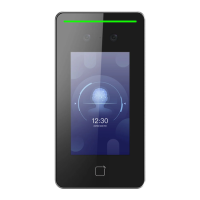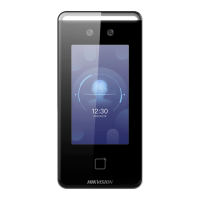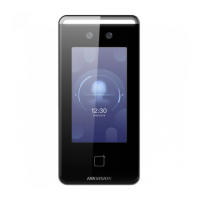
Do you have a question about the HIKVISION DS-K1T341B Series and is the answer not in the manual?
| Category | Touch Terminals |
|---|---|
| Display Type | LCD |
| Resolution | 1024 × 600 |
| Power Supply | DC 12 V ± 10% |
| Dimensions | 118.4 mm × 118.4 mm × 21.9 mm (4.7 inch × 4.7 inch × 0.9 inch) |
| Model | DS-K1T341B |
| Camera | 2 MP wide-angle lens |
| Operating System | Linux |
| Communication | TCP/IP, Wi-Fi |
| Ethernet | 10/100 Mbps |
| USB | USB 2.0 |
| Operating Temperature | -10 °C to +55 °C |
| Operating Humidity | 10% to 90% (non-condensing) |
| Face Recognition Accuracy | ≥ 99% |
| Face Recognition Duration | ≤ 0.2 s |
| Working Temperature | -10 °C to +55 °C |
| Working Humidity | 10% to 90% (non-condensing) |
Introduces the face recognition terminal as an access control device.
Lists key features like touch screen, camera specs, capacity, and connectivity.
Details the components and their locations based on the terminal diagram.
Provides guidance on optimal lighting and location to avoid backlight and sunlight.
Step-by-step instructions for installing the device using flush mounting.
Step-by-step instructions for installing the device using surface mounting.
Explains the function and connections of terminals like power input, RS-485, Wiegand, and door lock.
Illustrates how to wire the terminal with standard peripherals and provides important notes.
Details the wiring diagram for connecting the terminal with a secure door control unit.
Covers wiring diagrams for door open/locked scenarios during power loss, referencing specific scenarios.
Explains the process of activating the device directly through its interface.
Guides on activating the device using a web browser.
Details activation using the SADP tool for detecting and modifying device IP addresses.
Describes activating the device through the client software before adding it.
Guides on selecting the operating mode (Indoor/Others) for optimal device performance.
Explains how to add an administrator for managing device parameters after activation.
Covers logging into the device using administrator credentials or activation password.
Instructions for logging into the device using a web browser or client software.
How to view the live video feed from the device and perform related operations.
Details on adding, configuring, and managing person information, including basic details and cards.
Explains how to search for events using various criteria like employee ID, name, or time.
Covers various settings including local parameters, device info, time, network, video/audio, intercom, and access control.
Provides a flowchart illustrating the client software configuration process.
Covers adding, editing, deleting devices, and resetting passwords.
Details managing devices by creating groups, importing resources, editing, and removing them.
Encompasses adding organizations, configuring person info, issuing cards, managing photos, and import/export.
Covers setting up holidays and creating templates for schedules and access authorization.
Explains creating and applying access groups to define person access rights to doors.
Details advanced access control configurations like custom Wiegand, multi-factor auth, and anti-passback.
Setting up client and device actions triggered by access control events and card swipes.
Monitoring and remotely controlling door status and checking real-time access records.
Viewing real-time and historical events, enabling event reception, and searching events.
Covers attendance parameters, timetables, shifts, manual corrections, and leave/trip recording.
Suggests which fingers are best for scanning and provides correct/incorrect scanning techniques.
Advises on environmental conditions that affect fingerprint scanner performance.
Guides on correct positioning and distance for capturing face pictures.
Provides tips on maintaining a natural expression and avoiding accessories for clear face recognition.
Advises on positioning the face correctly towards the camera for accurate pictures.
Ensures the face is centered within the collecting window for optimal capture.
Provides reference values for different light sources (Candle, Bulb, Sunlight).
Recommends minimum distances from light sources, windows, and doors for installation.
Illustrates types of lighting to avoid for optimal device performance.
Directs users to a QR code for accessing the device communication matrix.
Directs users to a QR code for obtaining device common serial port commands.











